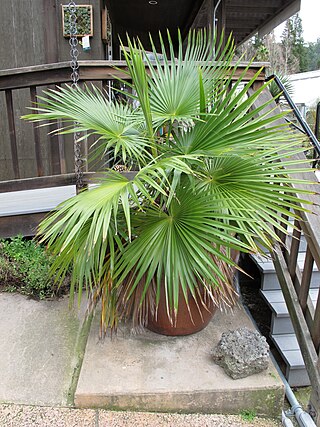
The International Union for Conservation of Nature (IUCN) Red List of Threatened Species, also known as the IUCN Red List or Red Data Book, founded in 1964, is an inventory of the global conservation status and extinction risk of biological species. A series of Regional Red Lists, which assess the risk of extinction to species within a political management unit, are also produced by countries and organizations.

Lactuca, commonly known as lettuce, is a genus of flowering plants in the family Asteraceae. The genus includes at least 50 species, distributed worldwide, but mainly in temperate Eurasia.

Acrocomia aculeata is a species of palm native to the Neotropics.
Cycas aculeata is a species of cycad in the genus Cycas, native to Vietnam, where it is endemic to a single site on the south slopes of the Hai Van Pass.

The sawback angelshark is an angelshark of the family Squatinidae It is one of rarest species of sharks known to date, and one of the three species of angelsharks that inhabits the Mediterranean. The Sawback angelshark lives in sandy and muddy bottoms of the ocean at depths of 30-500m.

The smoothback angelshark is an angelshark of the family Squatinidae found in the eastern Atlantic and Mediterranean.

Brahea edulis, the Guadalupe palm or palma de Guadalupe, is a palm endemic to Guadalupe Island, Mexico, although a few stands have been planted elsewhere. It is a fan palm which grows 4.50 to 13 metres tall. It grows on the island between 400 and 1,000 metres above mean sea level (ASL), with this altitudinal zonation producing one of the few fog oases present in North America.
Zapoteca aculeata is a species of flowering plant in the family Fabaceae, that is endemic to Tungurahua, Ecuador. Its natural habitat is subtropical or tropical moist montane forests.
Barnadesia aculeata is a species of flowering plant in the family Asteraceae. It is endemic to Ecuador, where it occurs in the central Andes. It grows in mountain shrubland above 2000 meters in elevation. It is vulnerable to habitat destruction.

Brahea calcarea is a species of palm. It is found in Guatemala and Mexico and is threatened by habitat loss.
Brahea pimo is a species of flowering plant in the family Arecaceae. It is found only in Mexico. It is threatened by habitat loss.

Cryosophila is a genus of medium-sized fan palms that range from central Mexico to northern Colombia. Species in the genus can be readily distinguished from related genera by their distinctive downward-pointing spines on the stem, which are actually modified roots. They are known as the "root spine palms".
Barleria aculeata is a species of plant in the family Acanthaceae. It is endemic to Yemen. Its natural habitat is subtropical or tropical dry forests.
Amauropelta aculeata, synonym Thelypteris aculeata, is a species of fern in the family Thelypteridaceae. It is endemic to Ecuador. Its natural habitat is subtropical or tropical moist montane forests. It is threatened by habitat loss.

Randia aculeata, commonly known as white indigoberry or white indigo berry, is a species in the Rubiaceae. It is a shrub or small tree that grows from 2 to 6 m tall. R. aculeata is native to Florida, Bermuda, the Bahamas, elsewhere among the Caribbean islands, and also from Mexico south through Central and South America to Colombia.

Acrocomia is a genus of palms which is native to the Neotropics, ranging from Mexico in the north, through Central America and the Caribbean, and through South America south to Argentina.

Pereskia aculeata is a scrambling shrub in the family Cactaceae. Common names include Barbados gooseberry, blade-apple cactus, leaf cactus, rose cactus, and lemonvine. It is native to tropical America. The leaves and fruits are edible, containing high quantities of protein, iron and other nutrients, and it is a popular vegetable in parts of the Brazilian state of Minas Gerais under the name of ora-pro-nóbis.

Hakea aculeata, commonly known as the column hakea, is a vulnerable species of the family Proteaceae found in the Wheatbelt region of Western Australia. An unusual sculptural species with dense columns of prickly foliage and plentiful clusters of strongly scented blooms in spring.
Seriatopora aculeata is a species of colonial stony coral in the family Pocilloporidae. It forms a bushy clump. It is native to the Central Indo-Pacific and the Oceanic West Pacific. Its range includes the Philippines, the Great Barrier Reef, Fiji, Indonesia, the Coral Sea, southern Madagascar and Vanuatu. It grows in shallow reef environments, at depths down to about 40 metres (130 ft). It is an uncommon species and subject to coral diseases and bleaching. The International Union for Conservation of Nature has assessed the conservation status of this species as being "vulnerable".













